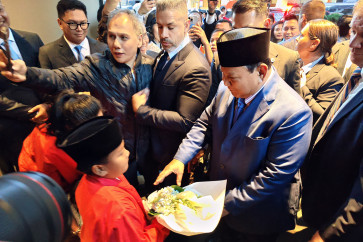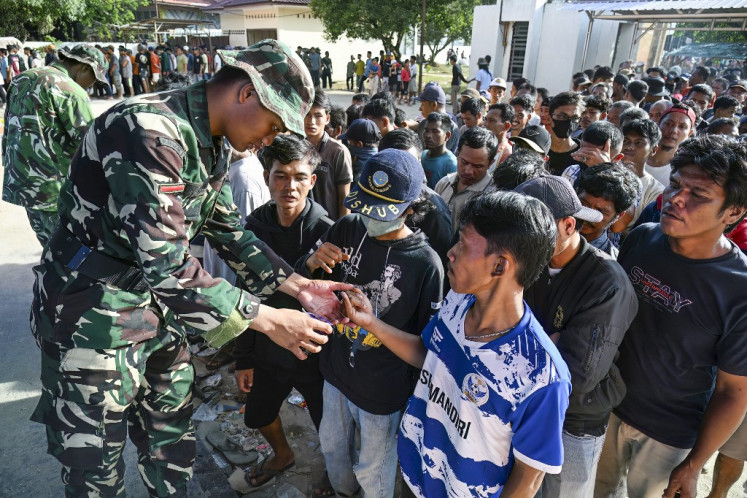Popular Reads
Top Results
Can't find what you're looking for?
View all search resultsPopular Reads
Top Results
Can't find what you're looking for?
View all search resultsWeekly 5: Jakarta — a melting pot of cultures
Since the beginning, Jakarta has been a melting pot of cultures
Change text size
Gift Premium Articles
to Anyone
S
ince the beginning, Jakarta has been a melting pot of cultures. Some of Jakarta’s native traditions are the products of marriages of different traditions from many nations and ethnic groups in Indonesia, namely Chinese, Arab, European, Javanese, and Sundanese. Let’s take a look at five parts of Betawi culture to see how diverse they are.
Gambang Kromong
The true blend of various cultures that shape Betawi can actually be seen on a small scale through Gambang Kromong.
This traditional Betawi orchestra has influences from Javanese gamelan ensembles and Western music, and is combined with a Chinese pentatonic scale (five notes per octave).
The orchestra consists of the gambang (a xylophone-like instrument), kromong (a set of small gongs), tehyan (a Chinese string instrument), flute, a percussion set, gongs and kecrek (a metal string instrument). Western instruments, including the electric guitar, trumpet, clarinet, saxophone, electric keyboard and Hawaiian guitar, are also played.
The singers, mostly female, sing pantun (lyrics written in Betawi dialects) with their shrill voices. They sing lagu sayur, the modern repertoire of gambang kromong.
Ethnomusicologist say that the texture of gambang kromong is similar to that of Javanese and Sundanese gamelan orchestras and also has echoes of the “small-band jazz” music popular in America and Europe in the 1920s and 1930s, not to mention the strong influence of Chinese music.
These orchestras usually accompany traditional Betawi dances, new dance performances and lenong (Betawi comedy shows).
Palang pintu
A traditional Betawi wedding may be one of the merriest celebrations among all the archipelago’s cultures.
The excitement begins with strings of firecrackers that are lit to welcome the arrival of the groom and his large entourage at the bride’s house.
But the bride’s family do not immediately allow the groom to enter the house and meet his bride until he completes the palang pintu tradition.
Palang pintu involves a dialogue between representatives of the bride and the groom, often mixed with funny Betawi rhymes and wordplay. The dialogue aims to explore the intentions of the groom’s entourage in coming to the bride’s house, through an exchange of rhymes.
In between exchanges, a silat martial arts duel — sometimes even involving the use of machetes — is also performed by experts from the bride and groom’s sides.
Although it seems that the tradition involves violence, it actually highlights the funny antics of the Betawi warriors. The groom’s side must triumph both in the duel and the poetry contest before the bride’s family lets him in to meet the bride. If he fails, the groom must theoretically give up his marital ambitions.
Palang pintu is also the name of an annual festival held in Kemang, South Jakarta.
Ondel-ondel
They are printed on T-shirts, become key chains, and decorate many kinds of souvenirs to remind visitors of Jakarta. Yes, ondel-ondel, or traditional Betawi effigies, have become the most famous Betawi icon.
The mask of the male puppet is usually painted red, while the female’s mask is painted with white.
The existence of ondel-ondel can be traced back to as early as the 18th century. During that period, the ondel-ondel were used to protect community from evil spirits.
The two puppets symbolize the spiritual protection provided to the Betawi population by their ancestors.
In the late 1960s and early 1970s, people still put on ondel-ondel shows during family celebrations, for example, when a boy in the family was circumcised.
Today, ondel-ondel are commonly used to spice up festivals, parades and other festivities.
Cokek dance
Clad in bright reds, yellows, greens or purples, cokek dancers sometimes make flirtatious gestures.
They touch each other’s chins, ears, shoulders, and pointing at each other’s nose.
The female dancers wear Betawi-style kebaya and shawls, while the male dancers wear shirts, sarongs and peci or songkok (cone-shaped, black felt caps).
The word “cokek” is derived from the Chinese word “cio kek”, which means “shawl”, referring to the garment used by female dancers to attract their male partners. But some also define it as a singer who also becomes a dancer.
The dance is believed to have been developed by Chinese landlords living in the capital. Until the World War II, only the ethnic Chinese performed the cokek dance.
During that time, cokek dancers did not only dance or sing, but also helped serve guests at feasts. Years later, the cokek dance, accompanied by gambang kromong orchestra, was often described as social dance.
Tanjidor
Tanjidor is one of the Betawi musical instruments that is greatly influenced by European music. Most of the instruments used in tanjidor are wind instruments, like the clarinet, piston, trombone and trumpet, and are played by seven to 10 people.
However, the name itself was taken from Portuguese’s “tangedor”, meaning stringed instruments.
Tanjidor was born during the Dutch colonial era, and became the music that belonged to and was played by slaves for their masters. It used to be played during festivals or wedding celebration, but today, tanjidor is often performed to welcome VIPs. — JP










